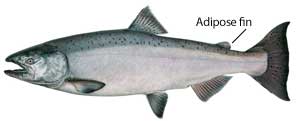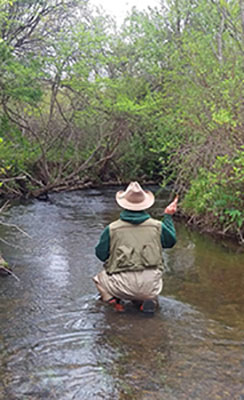- Details
(Provided by MDNR)
The Michigan Natural Resources Commission approved fishing regulation changes regarding lake trout and splake in lakes Michigan and Huron and Type F drowned river mouth lakes.
The regulation changes, which are now in effect, will result in expanded angling opportunities, including:
- Details
(Provided by MDNR)
 Report Marked and Tagged Salmon/>The Michigan DNR again this year is encouraging Great Lakes anglers who catch marked and tagged fish to report them.
Report Marked and Tagged Salmon/>The Michigan DNR again this year is encouraging Great Lakes anglers who catch marked and tagged fish to report them.
The DNR has used the coded-wire tag program to mass mark various fish species in Michigan since the 1980s. Mass marking provides critical data as fisheries biologists look to determine the value of naturally reproduced fish versus stocked fish, and lakewide movement of fish.
The coded-wire tag program involves implanting a small, coded-wire tag, which is invisible to the naked eye, into the snout of a fish. A fish containing a coded-wire tag can be identified because its adipose fin (the small, fleshy fin between the dorsal and tail fins) has been removed. An angler who catches a tagged fish then can record needed information about the fish, remove and freeze the fishís snout, and drop it off at a designated location. A statewide list of dropoff locations can be found on the DNR website.
For years the DNR primarily tagged Chinook salmon and lake trout as part of its mass marking effort in Lake Huron. Tagging these fish has helped biologists understand more about lakewide natural reproduction and how many wild fish are available in the Great Lakes. It also has helped determine if the percentage of wild fish varies from year to year and how fish stocking locations contribute to lake and river fisheries. Additionally, it provides insight into fish movement and where fish are stocked compared to where they are caught.
Because of the value of the information the mass marking effort brings, the DNR, in conjunction with the U.S. Fish and Wildlife Service, has continued to coded-wire tag all lake trout, Chinook and Atlantic salmon stocked into lakes Huron and Michigan, as well as a subsample of rainbow trout (steelhead) from the Au Sable River.
"We rely heavily on Michiganís anglers to return tagged fish and are appreciative of their cooperation," said Randy Claramunt, the DNR's Lake Huron Basin coordinator. "Participating in the DNRs mass marking effort allows us to learn more about the states fish species so we may manage them more effectively in the future."
Because of the vast number of fish marked by this method (millions annually), there are no longer rewards given to anglers for returning tagged fish. Any angler returning a coded-wire tagged fish to the DNR now will receive a letter describing the history of the fish caught (such as stocking location and age).
To learn more about the DNRs mass marking efforts, visit michigan.gov/taggedfish.
- Details
(Provided by IDNR)
The 2017 Indiana trout stream season opens Saturday, April 29, at 6 a.m. local time and runs through Dec. 31.
By Saturday morning, DNR fisheries personnel will have stocked nearly 22,000 rainbow trout in 17 streams across the state. The trout are produced at DNRís Curtis Creek Trout Rearing Station in LaGrange County.
In addition to rainbows, brown trout raised at Wolf Creek National Fish Hatchery will be stocked in mid-May. However, anglers may catch holdover browns from prior stockings in streams such as the Brookville Lake tailwater on the Whitewater River, Little Elkhart River, Solomon Creek and Pigeon River.
Information about Indiana trout stocking sites and the respective number of trout stocked at each is at wildlife.IN.gov/5457.htm .
- Details
(Provided by MDNR)
 Michigan's The latest additions to the Michigan DNR online Trout Trails application now ensure quality trout streams and lakes are pinpointed for anglers to visit throughout the state of Michigan.
Michigan's The latest additions to the Michigan DNR online Trout Trails application now ensure quality trout streams and lakes are pinpointed for anglers to visit throughout the state of Michigan.
Trout Trails is an interactive tool featuring fisheries biologist-verified trout waters that are often lesser known, but considered outstanding destination points.
This is the third phase of Trout Trails, with nearly 100 additional sites added to the application. That brings the total number of locations to nearly 300. These newly added sites feature lakes and streams located in the eastern, central and western Upper Peninsula and northern Lower Peninsula.
The DNR will continue to add more locations over time to add to the statewide coverage of these types of waters.
- Details
(Provided by MDNR)
The Michigan DNR, in partnership with Michigan Sea Grant, Michigan State University Extension, the U. S. Geological Surveys Great Lakes Science Center, the National Oceanic and Atmospheric Administrations Cooperative Institute for Limnology and Ecosystems Research, and local fishery organizations, will participate in several regional workshops the next two months highlighting research and information about the fisheries of Lake Erie, the Detroit River, Lake Huron, Lake Michigan and Lake St. Clair.
Workshops are free and open to the public, and will provide valuable information for anglers, charter captains, resource professionals and other community members. The workshops will focus on fish populations and angler catch data, native species, forage fish surveys, invasive species, updates on fisheries management activities, and other related topics.





